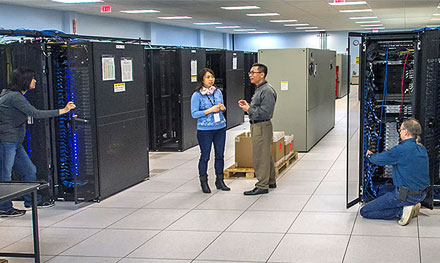Computation and Data-Driven Discovery (C3D): Components

Relativistic Heavy Ion Collider and the RHIC ATLAS Computing Facility
The Relativistic Heavy Ion Collider (RHIC) is a one-of-a kind particle accelerator that brings beams of gold and other ions traveling close to the speed of light into head-on collisions thousands of times per second to recreate and explore the conditions of the early universe, the inner components of protons, and the interactions of fundamental building blocks of visible matter. Two detectors, STAR and PHENIX, track the action by capturing data “snapshots” of select events, each of which may contain tracks of thousands of particles emerging from these collisions. The RHIC-ATLAS Computing Facility (RACF) receives that data, via dedicated fiber optic cables, archives it, and makes it available to about 1,000 RHIC scientists at Brookhaven Lab and institutions around the world to run analysis jobs on any of the facility’s 34,000 computing cores.

RHIC ATLAS Computing Facility.
ATLAS and the Large Hadron Collider
As the name implies, the RACF also supplies computing power to the ATLAS experiment at the LHC, in which Brookhaven scientists play several leading roles. With the detectors at the LHC producing 15 petabytes (PB)—15 million gigabytes—of data every year it’s running, and more than 8,000 scientists around the globe running up to 250,000 concurrent analysis jobs needing access to the entire dataset of 170 PB spread across the globally distributed computing facility, the LHC community has developed a worldwide grid for LHC computing. The requirements of this system have been driving the development of such distributed computing networks for the past decade. Brookhaven Lab’s RACF serves as a “Tier 1” center for all U.S. collaborators on the ATLAS experiment.
It provides about 25 percent of the total computing and storage resources to the ATLAS collaboration, receiving the raw data and promptly reconstructed data from the ATLAS Tier 0 center at CERN, and distributing it to Tier 2 and 3 computer centers across the country via the ESnet and Internet2 network infrastructure for physicists to analyze. Brookhaven scientists have developed unique software tools to manage these data distribution and computation needs, as well as software programs used to analyze the data to make new discoveries.




